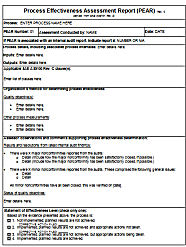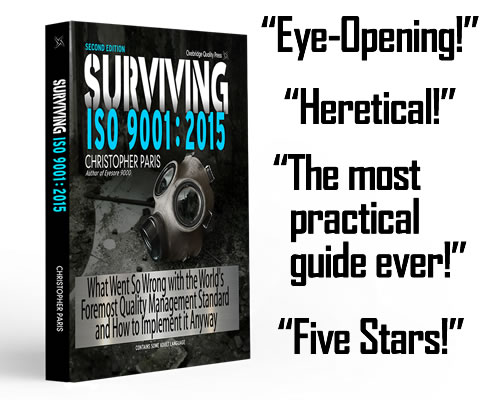Tampa FL — Oxebridge Quality Resources International has filed a formal request for clarification with the International Aerospace Quality Group (IAQG) on whether AS9100 certification body auditors can request, or require, clients to complete some or all of the Process Effectiveness Assessment Report (PEAR) form, a document used by auditors during AS9100 certification audits.
Oxebridge maintains that a strict reading of AS9101 rev D — the auditor standard which includes the PEAR form and its instructions for use — clearly requires the form be completed by the auditor, not the auditee. Controversy erupted on LinkedIn.com’s America’s Aerospace Quality Group (AAQG) forum when Oxebridge founder Christopher Paris first alerted aerospace officials of the practice.
NO RULING BY ANAB
Oxebridge had gone to the ANSI-ASQ National Accreditation Board (ANAB) for a ruling, and the accreditation body had been considering issuing a “Heads Up” industry alert on the matter. Today, Mr. Paris wrote to ANAB’s Randy Dougherty and told him that the company was taking the issue directly to the IAQG instead, saying “if ANAB were to issue a Heads Up, there’s a (small) possibility that the IAQG might later contradict it.”
Mr. Dougherty agreed that the IAQG was a better source for an opinion, saying that the issue would be better resolved by “[asking] the industry (via the AAQG RMC or IAQG OPMT) what their position is on this question.“
The IAQG develops the various AS standards, and manages the corresponding certification activities of registrars and auditors. ANAB can only uphold accreditation standards and IAQG rules, so it would not have been in a position to provide a definitive interpretation.
OXEBRIDGE’S POSITION
In a 4-page, 1600 word request, Oxebridge lays out the various clauses which, in its view, clearly indicate that the CB’s auditors must complete the PEAR form, and not the client. Oxebridge further maintains that because the PEAR form is a record of evidence, having clients fill out their own audit evidence dramatically jeopardizes the independence and objectivity of the accredited certification process.
Preliminary opinions from some industry leaders, including ANAB’s Randy Dougherty and Plexus representative Jim Collins, show disagreement with Oxebridge on the issue. These parties instead feel that while the responsibility for completing the PEAR form lies with the auditor, it is not “for a CB to send the forms to their client in advance of an audit to have the client complete part of the form. The client should be able to describe how they measure their processes.” (Randy Dougherty)
French accreditation body COFRAC also referred the matter to IAQG.
Oxebridge’s argument is that the information required on the PEAR form should have already been defined in a client organization’s QMS documentation per the requirements of clauses 4.1 and 5.2.4, both of which have existed in the standard since the release of ISO 9001:2000 over a decade ago. “If CB’s haven’t been verifying that clients have identified their processes,” Mr. Paris says, “then they should have been writing nonconformities under ISO 9001 twelve years ago, never mind under AS9100.”
This means that for presently-certified companies, the evidence for the PEAR already exists in documentation and records on file with the registrars. For new clients, all they would need do to provide the information for a PEAR is submit the normal documentation and records required for a Stage 1 document review.
COSTS TO CLIENTS
Oxebridge maintains that CB’s are offloading work to clients which both CB contracts and accreditation standards require by to be done by the registrar.
The larger problem is the unnecessary costs associated with completing paperwork for CB auditors. In late 2011, Oxebridge spent a full week working on PEARs for one of its larger aerospace clients, working alongside a Quality Engineer who had to be reassiged from his normal duties for that week to assist. According to Mr. Paris, “The client already had full process maps and process measurement data going back to 2006, but the registrar was pushing ahead with PEARs and turtle diagrams nonetheless.” Oxebridge estimates the endeavor cost the client over $8,000 in consulting fees, expenses, lost staff wages and time. This does not include the money already paid to the registrar for conducting the certification audit itself, which — according to Oxebridge’s interpretation of the AS9101 standard — requires the auditor to complete all associated audit paperwork.
Defenders of the practice seem to think that “helping the auditors complete the forms” is light work, incurring no costs. Oxebridge’s experiences prove otherwise.
INCREASE AUDIT DAYS?
 The problem grew to such a crescendo that Oxebridge has released a free “Internal PEAR” downloadable form to assist companies in preparing for their AS9100 audits.
The problem grew to such a crescendo that Oxebridge has released a free “Internal PEAR” downloadable form to assist companies in preparing for their AS9100 audits.
Between August and November of 2011, Oxebridge had been offering”PEAR assistance services” for free for clients, but when the number of clients coming forth began impacting the schedules of other implementation clients, “we had to start saying no, and assessing a fee,” Mr. Paris said. “We kept raising the fee in the hopes that clients would push back against their registrars on this, but there’s too much fear. They just want to placate those auditors.”
Oxebridge has since stopped offering the service, and instead is including PEAR development as part of its Rapid AS9100 Implementation services.
In a letter to ANAB, Mr. Paris wrote:
If CB’s have to increase the days to comply with the standards, the solution is to increase the days. The IAAR may not like it, but if they want to comply with the letter of the law, that’s what they have to do. Besides, some CB’s will figure out how to efficiently accomplish all the requirements without raising their rates or day counts, and the market will drive business to them. Technology investments are one such option; it’s incredible that in this day and age auditors are still submitting hand-written audit reports.
Oxebridge did not utilize the IAQG’s OASIS database feedback portal to submit its request, fearing the request would not recieve the immediate attention it needs, and because the portal is designed to provide feedback against specific CB’s or accreditation bodies, not for general interpretation issues.
On January 30th, IAQG President Xavier Sahut d’Izarn confirmed receipt of the request, and indicated that it has been forwarded to Tim Lee, Head of IAQG Other Party Management Team, “for due consideration.”
“We hope the IAQG will rule quickly on this,” Mr. Paris said. “AS9100 gets a black eye every day this issue is unresolved.”
(This piece was updated on Feb 2 2011 to reflect COFRAC’s feedback, and to add the IAQG’s response.)
Christopher Paris is the founder and VP Operations of Oxebridge. He has over 35 years’ experience implementing ISO 9001 and AS9100 systems, and helps establish certification and accreditation bodies with the ISO 17000 series. He is a vocal advocate for the development and use of standards from the point of view of actual users. He is the writer and artist of THE AUDITOR comic strip, and is currently writing the DR. CUBA pulp novel series. Visit www.drcuba.world







